Allie Linn/C. Klockner
Key: Allie Linn | C. Klockner | Collaborative
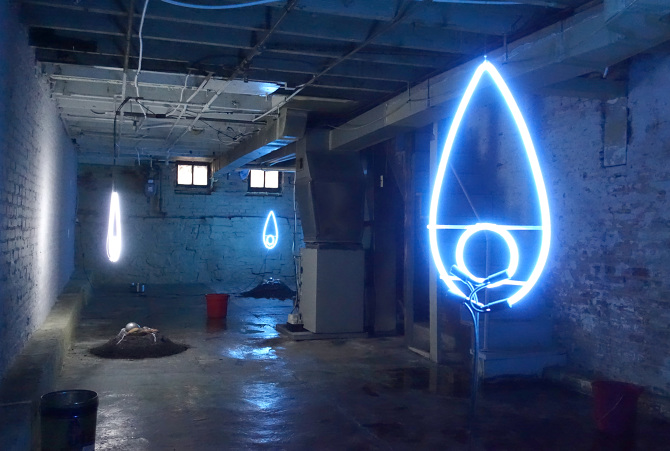
Two haunted house stories: in Agatha Christie’s 1976 work Sleeping Murder, a recently purchased English countryside estate quickly generates chilling déjà vu for its new tenant, newlywed Gwenda Reed, as she begins to initiate renovations throughout the home. Gwenda finds that the estate seems to respond to her own thoughts: upon beginning the addition of a new doorway between two rooms, she discovers that one has already existed there, and as she strips the wallpaper in the future nursery, she finds the new paper that she has in mind already installed beneath. Before Gwenda can logically remember the truth, she viscerally feels it: that she has already spent time in this home as a small child, that she is the only one haunting the house.
In 1977, one year after Christie’s novel, director Nobuhiko Obayashi released the horror-comedy film Hausu in a similar vein of home architecture exerting a life of its own. In contrast to Christie’s text, where this agency is revealed as the repressed history of intimate knowledge, the film’s protagonist Gorgeous finds that the murderous objects in the house are violently haunted by her aunt’s grief over a husband that never returned from war. The portrayal of home as antagonist is at odds with more common, inviting depictions of domestic space and in this subversion of trope, Hausu and Sleeping Murder underscore the affectual potential of built architecture: inhabitants influence space and space influences its inhabitants.
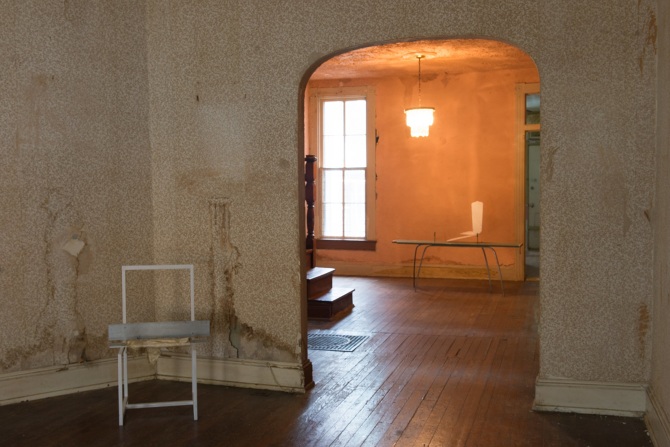
Houses are familiar territory for art in Baltimore. In 2013, Max Guy wrote the article “The Baltimore House Gallery Phenomenon.”1 He paints a picture of an art community defined through a variety of lenses: in its use of domestic space as gallery space, in its logics of camaraderie as curatorial impulse, and in its shared isolation not only from art capitals but from a broader network of other small art communities. Despite the casually domestic conditions, “The walls are white and dedicated to the presentation of art”—a cursory gesture to how these spaces should be understood.
Five years on, it’s refreshing to look back on writing that sidesteps stale accolades regarding alternative spaces. Instead: “an all-of-my-friends approach to curating can make bland exhibitions.” Incorporating the history of apartment galleries in places like Chicago into one of many canons, we move beyond novelty and get more specific about the effect of and the intention of using these spaces. A question regarding criticality stayed in flux here for Guy when the distinction between these spaces as galleries or as house parties remained blurry, but this also didn’t diminish the value of this community’s amateurish ambition.

In the context of that writing, the introduction of Rowhouse Project in Remington has good comic timing, as if in malicious compliance to Guy’s critique. Operated between Summer 2014 and Spring 2016, Rowhouse Project embodied a model that was both more domestic than the galleries that Guy references and more clearly dedicated to the presentation of art. As site, the space was charged in its specificity as rowhouse, as a residence in Remington, as a home that was built in layers; it not only heavily affected the objects placed inside of it, but seemed to physically create those objects in their entirety.2 The house itself perhaps found a lineage in other domestic interrogations—Judy Chicago and Miriam Schapiro’s Womanhouse, David Ireland’s 500 Capp Street, Gregor Schneider’s Haus Ur, or Kurt Schwitters’ Merzbau3—but with its politics situated mostly in the house’s extreme placed-ness, at times to the neighborhood itself; at others, to the history of construction that this house’s architecture embodied.4
Within that question of the project’s locale, the rowhouse’s plural identities—as rowhouse, as Huntingdon Ave., as Remington neighborhood, as Baltimore, as America—become central contextual items. Justin Leiberman addresses the role of “critical” art being shown in non-gentrified places; Josh Tonsfeldt interrogates the architectural history as well as the traces left in the house; Cynthia Daignault’s residency functions as a social project in which the surrounding community was the core subject of the resulting show; for Trevor Shimizu and Van Hanos, reflections on their past relationships with Baltimore City become interwoven with their work; for Ajay Kurian, the site becomes post-9/11 America.
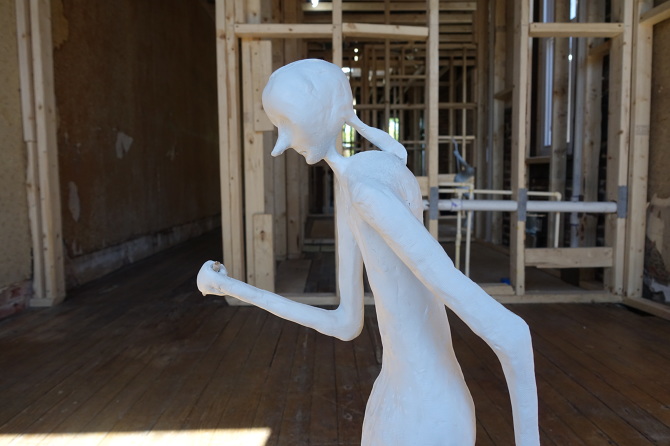
As for the building itself, Rowhouse Project also seemed to have a life of its own. The basic mode of operation in its two year life followed an arc that started with a residential interior that seemed to be falling apart behind stained wallpaper. The structure was slowly stripped down to its skeleton, dramatically shifting between shows. With Ajay Kurian’s exhibition Work Harder Under Water, the plastered walls disappeared and the underlying lath was revealed.5 In a piece in which two sadistic cyborg boys pissed on a third, a plumbing system of water was built into the structure of the house so that the stream from the second floor trickled into a basement that glowed blue with hanging neon Neighborhood Watch eyes. Here, perhaps most explicitly, has the house been reimagined as an affectual and deviant body. The Neighborhood Watch eyes impart the house with vision, and the multilevel fountain doubles as both plumbing and digestion, trapping its participants in an cyclical performance of torture.
Rowhouse Project might be described as an acceleration of the malleability of any built environment. The apparent permanence of built architecture proves to be quite plastic, engaging in a long-term back and forth between tenants. Renovations and alterations “persistently retire or reshape buildings,” Stewart Brand writes in How Buildings Learn. “First we shape our buildings, then they shape us, then we shape them again–ad infinitum.”6 A building itself becomes a kind of indexical archive, capturing both conscious alterations (renovations, expansions) and unconscious ones (wear, desire lines, decay) left by a string of tenants. To see the walls of Rowhouse Project painted, stripped, demolished, and rebuilt in a span of mere months places the domestic space in conversation with the changing seasons; aptly, how its shows have been archived: the leaves fall, flora becomes dormant, new walls are erected.
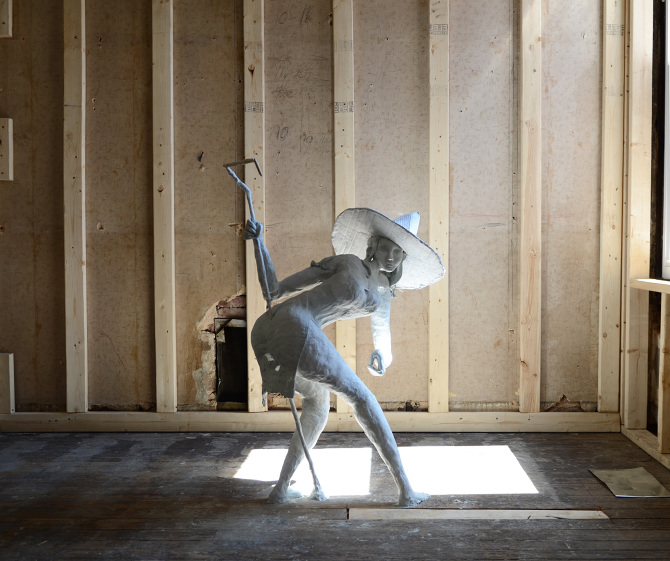
Rowhouse Project was not the house gallery that Guy describes, which would be better rearticulated through Lane Relyea’s terms as “the cash strapped activity at the low end, all the freshly graduated do-it-yourselfers who rehearse in increasingly remote cities and neighborhoods the gentrifying pattern of improvising exhibitions out of bars, hotel rooms, laundromats, whatever venues are at hand.”7 Instead, it was a fairly well-connected exhibition space with a very specific notion of site, a non-commercial intention, and a unique mode of collaboration that intersected with the House Gallery sphere from a distant starting point. At its best, the push and pull between architecture and the gallery’s program developed a collaboration that was more striking than any one artist or curator’s contribution to the whole.
While Rowhouse Project was archived through an online component (along with a sizable printed publication), the triad relationship between the uncovered layers of the house’s history, the haunting of affect, and the house’s site-specificity revealed something of an analog virtuality that existed within the structure itself. Elizabeth Grosz builds on this concept of pre-digital virtuality in her 2001 text Architecture From The Outside: “The invention of electronically generated media does not introduce us for the first time to virtuality but rather renders virtuality more graphic.”8 She expands the notion of the virtual as she points towards letter writing, reading, and painting–the things that evoke constructed, imaginary, and mutable spaces–as key sites of pre-digital virtuality, which opens up a suggestion of the Rowhouse as a virtual entity that simultaneously hosts multiple iterations of itself.
This understanding of virtuality is more effective than the one employed in some post-internet practices that limit this conversation to one of non-space and documentation circulation. Instead, the place becomes “Rowhouse” as thing-in-itself, a false noumenon stitched together through the seams of phenomena, a temporally flattened space. This is a virtuality that does not attempt to remove the gallery’s relationship to locale.9 Further, these threads point towards an understanding of place through hauntings of affect. In her review in this publication of Ajay Kurian’s exhibition, Quintessa Matranga references an observation from Bachelard’s Poetics of Space, “that the structure of the house parodies the human psyche.” Architecture as projected psychic interiority creates an intersection between feeling and place that cultivates virtuality as well, here.
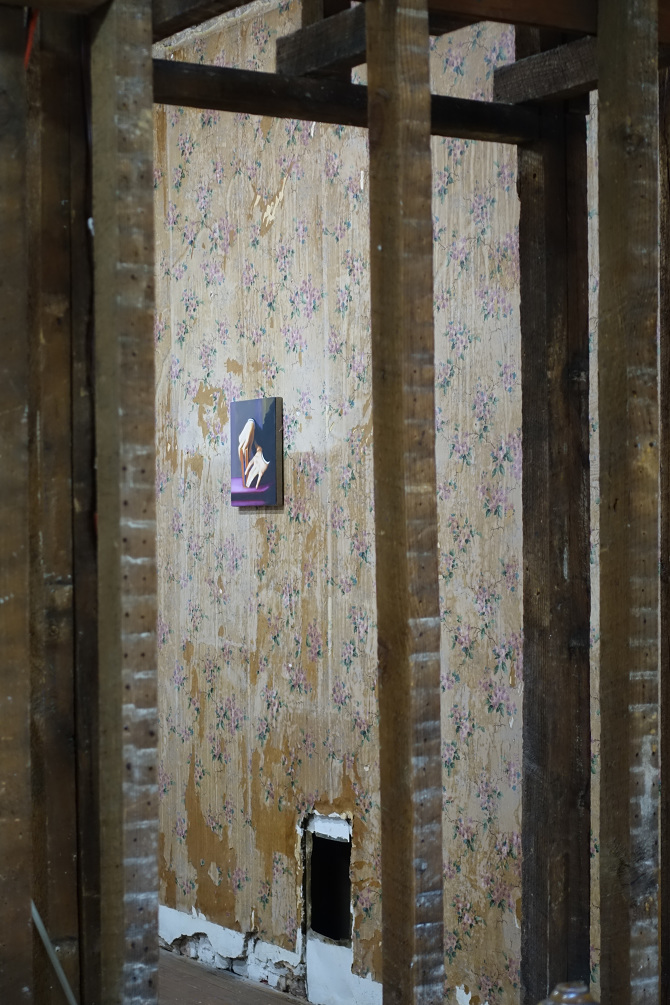
Working within the confines of domestic space is, of course, not a new gesture, and Rowhouse Project continues a trajectory of domestic curating that includes Hans Ulrich Obrist’s 1991 kitchen show, World Soup, and the 1986 multi-venued Chambres d’Amis in Ghent, Belgium.10 In these examples, the alteration or intervention of preexisting architecture is often minimal: how much can the psychology of the space be manipulated with minimum disruption? It is a question that continues to be explored, and though the gesture of transforming domestic space into curatorial venue is hardly a radical one given its long history, it does create space for a more phenomenological experience, one in which no aspect of the environment recedes into neutral background. One recent example of this exploration is The Pond, a multi-room and multi-floor installation by Jordan Loeppky-Kolesnik at the Anderson in Richmond, VA. The Pond occupied four floors of the Anderson, inviting viewers to begin on the top level and make their way down through a back staircase and adjacent rooms. Located within an otherwise traditional white cube, this section of the building had previously been reserved for storage.
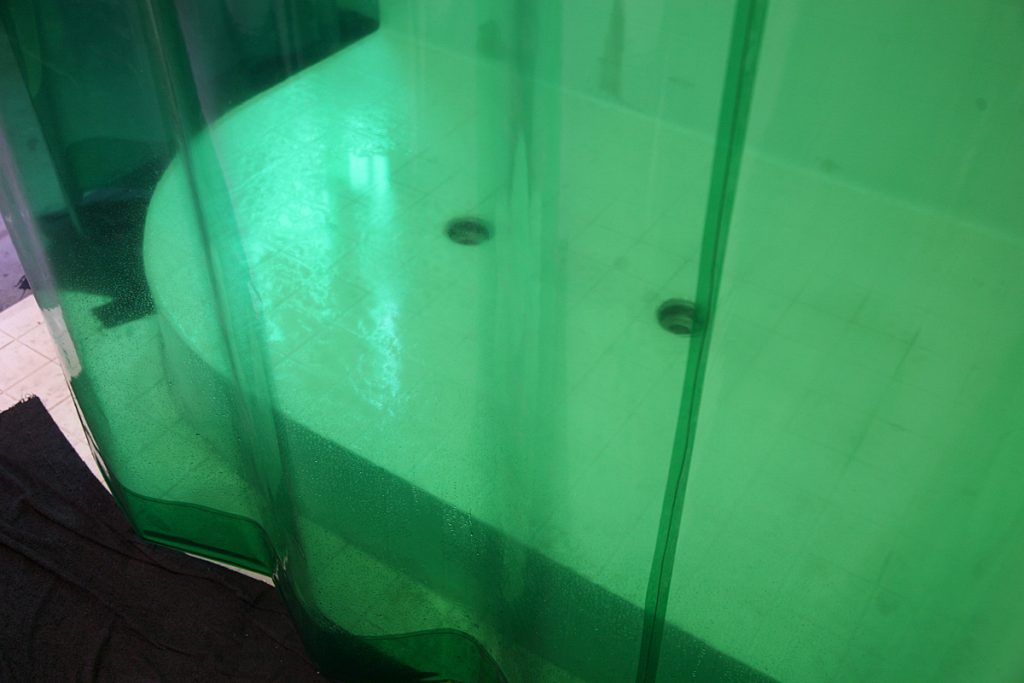
In The Pond, as in much of their work, Loeppky-Kolesnik blurs new constructed realities of a space with existing versions of itself in order to project psychological, virtual space onto the physical. An existing sink blends in with a newly constructed shower complete with dual drains (an absent intimacy), while various video monitors embed narrative into different corners of the space. Newly constructed walls, windows, and HVAC vents blend with existing ones so that the artist’s interventions to the space become nearly invisible. Navigating the labyrinthine rooms imbues the traditionally neglected space with a degree of care and attention: every wasp nest, overgrown creeping vine, and graffiti tag enters the extensive install.
And audience navigation is a crucial part of how The Pond exists. The viewer moves through rooms with changing light and climates, experiencing an increasingly humid, foggy atmosphere from humidifiers and running water on the upper level and the transition of artificial white light to diffused green light to near-darkness in the basement. The spell is eventually broken upon departure, when the viewer is spit out into the harsh bright sunlight of the outdoor world.
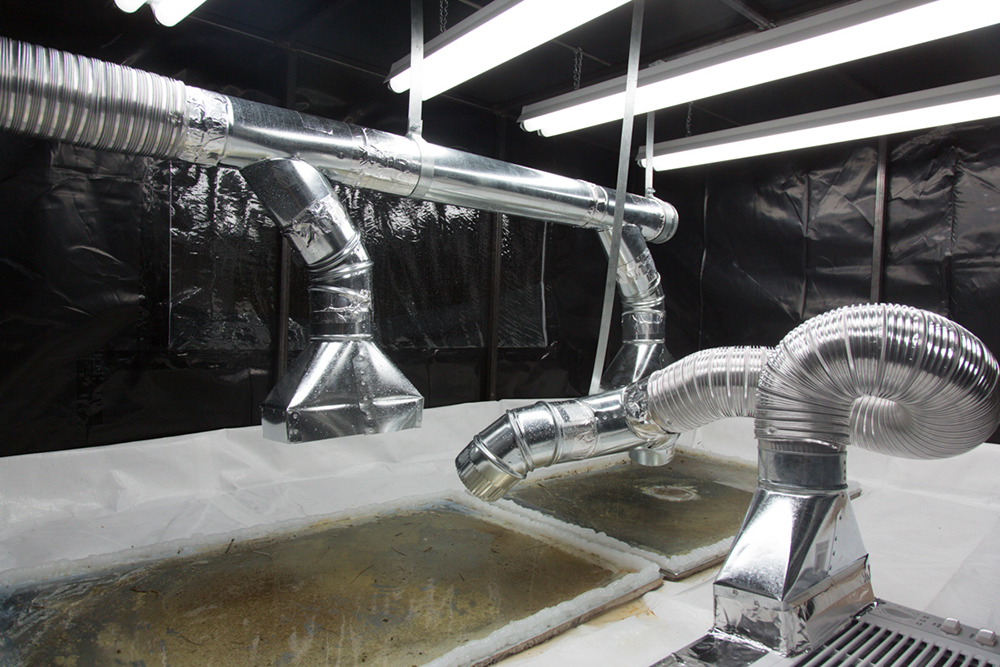
“It has everything to do with desire and filth,” reads one subtitle against a dark marshy landscape from one of the installed videos. Equally erotic and repulsive, the empty bathrooms, bedrooms, and utility rooms that Loeppky-Kolesnik contrives are markedly vacant but filled with detritus from intimate encounters: an arranged bouquet of stinging nettle, an initialed heart drawn on the wall, a continuously running shower. The building has begun to decay and devour this oft-neglected area, and Loeppky-Kolesnik preserves and reanimates the artifacts left behind. It is a space both deviant and tender, conducive to an intimate encounter on the foam mats or in the shower but disrupted by the horror of a sink filled with tadpoles. Its histories compress into a surreal collection of relics and poems, providing just a peek into the activities that may have previously taken place inside.
Between both Rowhouse Project and these other adjacent projects, hauntings are experienced when a latent presence intersects with existing environment. Seemingly, however, there is negligible distinction between how different virtual spaces (past, psychological present, future) overlap with real space. Their shared virtual status blurs the origins of these affectual, real, and temporal spaces. As a collaborative endeavor, Rowhouse Project approaches place and virtuality in a way that opens up a useful poetics and addresses a larger question of locale. The ways that this platform facilitates spatial intervention, both in subtlety and in scale, become points of reference for how to deal with real space, something which will always contend with the presences of affect, past, and future.
Note: A special thanks to Corin Hewitt and Meggie Kelley for their additions to this research. Images courtesy of Rowhouse Project and Jordan Loeppky-Kolesnik. Additional line edits added November 14, 2022.